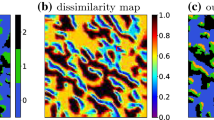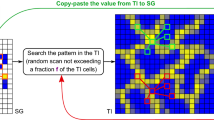Abstract
Continuous growth of multiple-point simulation algorithms for modeling environmental variables necessitates a straightforward, reliable, robust, and distinctive method for evaluating the quality of output images. A good simulation method should produce realizations consistent with the training image (TI). Moreover, it should be capable of producing diverse realizations to effectively model the variability of real fields. In this paper, the pattern innovation capability is evaluated by estimating the coherence map using keypoint detection and matching, without assuming any access to the simulation process. Local binary patterns, as distinctive and effective texture descriptors, are also employed to evaluate the consistency of realizations with the TI. Our proposed method provides absolute measures in the interval [0,1], allowing MPS algorithms to be evaluated on their own. Experiments show that the produced scores are consistent with human perception and robust for different realizations obtained using the same method, allowing for a reliable judgment using a few realizations. While a human observer is highly sensitive to discontinuities and insensitive to verbatim copies, the proposed method considers both factors simultaneously.
Similar content being viewed by others
References
Mariethoz, G., Lefebvre, S.: Bridges between multiple-point geostatistics and texture synthesis: Review and guidelines for future research. Comput. Geosci. 66, 66–80 (2014)
Mariethoz, G., Linde, N., Jougnot, D., Rezaee, H.: Feature-preserving interpolation and filtering of environmental time series. Environ. Model Softw. 72, 71–76 (2015)
Mariethoz, G., Caers, J.: Multiple-point geostatistics: stochastic modeling with training images. John Wiley & Sons, Hoboken (2014)
Guardiano, F.B., Srivastava, R.M.: Multivariate geostatistics: beyond bivariate moments. In: Geostatistics Troia’92, pp. 133–144. Springer, Berlin (1993)
Abdollahifard, M.J., Faez, K.: Fast direct sampling for multiple-point stochastic simulation. Arab. J. Geosci. 7, 1927–1939 (2014)
Mariethoz, G., Renard, P., Straubhaar, J.: The direct sampling method to perform multiple-point geostatistical simulations. Water Resour. Res. 46, (2010)
Strebelle, S.: Conditional simulation of complex geological structures using multiple-point statistics. Math. Geol. 34, 1–21 (2002)
Boucher, A.: Considering complex training images with search tree partitioning. Comput. Geosci. 35, 1151–1158 (2009)
Huysmans, M., Dassargues, A.: Direct multiple-point geostatistical simulation of edge properties for modeling thin irregularly shaped surfaces. Math. Geosci. 43, 521 (2011)
Mariethoz, G., Straubhaar, J., Renard, P., Chugunova, T., Biver, P.: Constraining distance-based multipoint simulations to proportions and trends. Environ. Model Softw. 72, 184–197 (2015)
Honarkhah, M., Caers, J.: Stochastic simulation of patterns using distance-based pattern modeling. Math. Geosci. 42, 487–517 (2010)
Mahmud, K., Mariethoz, G., Caers, J., Tahmasebi, P., Baker, A.: Simulation of Earth textures by conditional image quilting. Water Resour. Res. 50, 3088–3107 (2014)
Tahmasebi, P., Sahimi, M., Caers, J.: MS-CCSIM: accelerating pattern-based geostatistical simulation of categorical variables using a multi-scale search in Fourier space. Comput. Geosci. 67, 75–88 (2014)
Abdollahifard, M.J.: Fast multiple-point simulation using a data-driven path and an efficient gradient-based search. Comput. Geosci. 86, 64–74 (2016)
Li, X., Mariethoz, G., Lu, D., Linde, N.: Patch-based iterative conditional geostatistical simulation using graph cuts. Water Resour. Res. 52, 6297–6320 (2016)
Parra, A., Ortiz, J.M.: Adapting a texture synthesis algorithm for conditional multiple point geostatistical simulation. Stoch. Env. Res. Risk A. 25, 1101–1111 (2011)
Abdollahifard, M.J., Faez, K.: Stochastic simulation of patterns using Bayesian pattern modeling. Comput. Geosci. 17, 99–116 (2013)
Tahmasebi, P., Hezarkhani, A., Sahimi, M.: Multiple-point geostatistical modeling based on the cross-correlation functions. Comput. Geosci. 16, 779–797 (2012)
Rezaee, H., Marcotte, D., Tahmasebi, P., Saucier, A.: Multiple-point geostatistical simulation using enriched pattern databases. Stoch. Env. Res. Risk A. 29, 893–913 (2015)
Abdollahifard, M.J., Ahmadi, S.: Reconstruction of binary geological images using analytical edge and object models. Comput. Geosci. 89, 239–251 (2016)
Tan, X., Tahmasebi, P., Caers, J.: Comparing training-image based algorithms using an analysis of distance. Math. Geosci. 46, 149–169 (2014)
Lange, K., Frydendall, J., Cordua, K.S., Hansen, T.M., Melnikova, Y., Mosegaard, K.: A frequency matching method: solving inverse problems by use of geologically realistic prior information. Math. Geosci. 44, 783–803 (2012)
Endres, D.M., Schindelin, J.E.: A new metric for probability distributions. In: IEEE Transactions on Information theory (2003)
Abdollahifard, M.J., Baharvand, M., Mariéthoz, G.: Efficient training image selection for multiple-point geostatistics via analysis of contours. Comput. Geosci. 128, 41–50 (2019)
Pérez, C., Mariethoz, G., Ortiz, J.M.: Verifying the high-order consistency of training images with data for multiple-point geostatistics. Comput. Geosci. 70, 190–205 (2014)
Lowe, D.G.: Distinctive image features from scale-invariant keypoints. Int. J. Comput. Vis. 60, 91–110 (2004)
Ojala, T., Pietikainen, M., Maenpaa, T.: Multiresolution gray-scale and rotation invariant texture classification with local binary patterns. IEEE Trans. Pattern Anal. Mach. Intell. 24, 971–987 (2002)
Heeger, D.J., Bergen, J.R.: Pyramid-based texture analysis/synthesis. In: Proceedings of the 22nd annual conference on Computer graphics and interactive techniques, pp. 229–238. ACM, New York (1995)
Sharifzadehlari, M., Fathianpour, N., Renard, P., Amirfattahi, R.: Random partitioning and adaptive filters for multiple-point stochastic simulation. Stoch. Env. Res. Risk A. 32, 1375–1396 (2018)
Kalantari, S., Abdollahifard, M.J.: Optimization-based multiple-point geostatistics: A sparse way. Comput. Geosci. 95, 85–98 (2016)
Pourfard, M., Abdollahifard, M.J., Faez, K., Motamedi, S.A., Hosseinian, T.: PCTO-SIM: Multiple-point geostatistical modeling using parallel conditional texture optimization. Comput. Geosci. 102, 116–138 (2017)
Yang, L., Hou, W., Cui, C., Cui, J.: GOSIM: a multi-scale iterative multiple-point statistics algorithm with global optimization. Comput. Geosci. 89, 57–70 (2016)
Szeliski, R.: Computer vision: algorithms and applications. Springer Science & Business Media, Berlin (2010)
Harris, C., Stephens, M.: A combined corner and edge detector. In: Alvey vision conference, vol. 50, pp. 10–5244. Citeseer (1988)
Mariethoz, G., Kelly, B.F.: Modeling complex geological structures with elementary training images and transform-invariant distances. Water Resour. Res. 47, (2011)
Guibas, L.J., Knuth, D.E., Sharir, M.: Randomized incremental construction of Delaunay and Voronoi diagrams. Algorithmica. 7, 381–413 (1992)
Heikkilä, M., Pietikäinen, M., Schmid, C.: Description of interest regions with local binary patterns. Pattern Recogn. 42, 425–436 (2009)
Ahonen, T., Hadid, A., Pietikainen, M.: Face description with local binary patterns: Application to face recognition. IEEE Transactions on Pattern Analysis & Machine Intelligence. 2037–2041 (2006)
Guo, Z., Zhang, L., Zhang, D.: A completed modeling of local binary pattern operator for texture classification. IEEE Trans. Image Process. 19, 1657–1663 (2010)
Abdollahifard, M.J., Nasiri, B.: Exploiting transformation-domain sparsity for fast query in multiple-point geostatistics. Comput. Geosci. 21, 289–299 (2017)
Acknowledgments
The authors would like to express their sincere thanks to anonymous reviewers who devoted their time and expertise to improving this paper. Their comments helped us in improving the paper presentation and proposed formulations.
Author information
Authors and Affiliations
Corresponding author
Additional information
Publisher’s note
Springer Nature remains neutral with regard to jurisdictional claims in published maps and institutional affiliations.
Rights and permissions
About this article
Cite this article
Abdollahifard, M.J., Mariéthoz, G. & Ghavim, M. Quantitative evaluation of multiple-point simulations using image segmentation and texture descriptors. Comput Geosci 23, 1349–1368 (2019). https://doi.org/10.1007/s10596-019-09901-z
Received:
Accepted:
Published:
Issue Date:
DOI: https://doi.org/10.1007/s10596-019-09901-z




